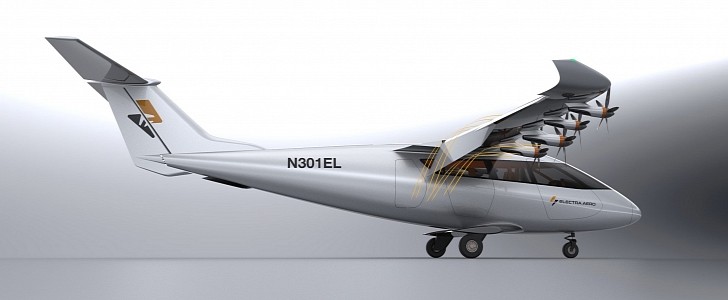Electra might not sound familiar to a lot of us, but this aviation company is taking off quite literally. After being selected a few months ago by the U.S. Air Force to develop aircraft based on electric vertical takeoff and landing technologies (eVTOLs), it has now partnered with the National Aeronautics & Space Administration (NASA), for developing these cutting-edge technologies even further.
Electra is known for creating an innovative electric ultra-short takeoff and landing (eSTOL) aircraft based on hybrid-electric propulsion. Its most uncommon feature is the blown lift technology, an advanced aerodynamic concept that allows the aircraft to take off at a fraction of the power typically required by eVTOLs, using the same amount of ground space. According to Electra, this eSTOL can take off and land in less than 150 feet.
Plus, it’s equipped with a hybrid-electric turbo-generator that powers the 8 motors and charges the battery during the flight. The benefit of this system is that it doesn’t require flying back to a ground base for recharging, or any special infrastructure, making this aircraft particularly efficient and sustainable.
In order to take the blown lift concept development even further, Electra has been awarded a NASA contract, under the Small Business Technology Transfer (STTR) program. Together with Dr. Alejandra Uranga, Gabilan Assistant Professor at the University of Southern California's (USC) Department of Aerospace and Mechanical Engineering, the company will develop computational methods for testing and configuring the future aircraft.
According to Ben Marchionna, Electra's Director of Technology and Innovation, blown lift and distributed electric propulsion models require full-scale vehicle validation, which is difficult to achieve. Computational fluid dynamics (CFD) methods are used for prediction at a lower scale, but eSTOL design needs faster methods that can accelerate the evaluation process of various design choices. This is what the new contract will help develop.
The full-scale hybrid eSTOL tech demonstrator aircraft is set to begin flight testing in 2022. As part of both STTR program and USAF’s Agility Prime program, Electra has all the advantages for bringing an amazing eSTOL on the market.
Plus, it’s equipped with a hybrid-electric turbo-generator that powers the 8 motors and charges the battery during the flight. The benefit of this system is that it doesn’t require flying back to a ground base for recharging, or any special infrastructure, making this aircraft particularly efficient and sustainable.
In order to take the blown lift concept development even further, Electra has been awarded a NASA contract, under the Small Business Technology Transfer (STTR) program. Together with Dr. Alejandra Uranga, Gabilan Assistant Professor at the University of Southern California's (USC) Department of Aerospace and Mechanical Engineering, the company will develop computational methods for testing and configuring the future aircraft.
According to Ben Marchionna, Electra's Director of Technology and Innovation, blown lift and distributed electric propulsion models require full-scale vehicle validation, which is difficult to achieve. Computational fluid dynamics (CFD) methods are used for prediction at a lower scale, but eSTOL design needs faster methods that can accelerate the evaluation process of various design choices. This is what the new contract will help develop.
The full-scale hybrid eSTOL tech demonstrator aircraft is set to begin flight testing in 2022. As part of both STTR program and USAF’s Agility Prime program, Electra has all the advantages for bringing an amazing eSTOL on the market.





